September 18, 2011
Originally established by artists Julieta Aranda and Anton Vidokle in New York in 2008, PAWNSHOP went bankrupt at the beginning of the world financial crises, only to re-open successfully in Beijing and, most recently, at Art Basel.
Structurally, a pawnshop is a short-term loan business, which retains a collateral object (a camera, a ring, a guitar, a gun, and in this case an artwork) in exchange for a cash loan—a small fraction of the object’s value that needs to be repaid with interest within a one-month period. If the owner of the pawned object does not return to collect it and repay the loan + interest within 30 days, the pawnbroker has the right to sell it.
What is of particular interest in pawnshops is the peculiar mixture of the illicit and the desperate, futurity and anticipation. The idea that the object is collateral for cash that might be traded back for the object during a set duration, could be put in other words, that works of art and money are just dancing in a choreography in which they might just circle back and meet again, and cancel each other out, but in fact rarely do.
All profits from PAWNSHOP have been donated to Doctors Without Borders.
PAWNSHOP Inventory: Lucas Ajemian, Armando Andrade, Florian Aner, Artemio, Michael Baers, Christin Berg, Bik Van Der Pool, Julien J. Bismuth, Chloe Briggs, Mike Bouchet, Svetlana Boym, Francois Bucher, Andrea Büttner, Etienne Chambaud, Herman Chong, Branka Cvjeticanin, William Diaz, NICO DOCKX, Gardar Eide Einarsson, Annika Eriksson, Köken Ergun, Jakup Ferri, Jean-Pascale Flavien, Harrell Fletcher, Iris Flügel, Egan Frantz, Peter Freidl, Jaime Gecker, Carmen Gheorghe, Barbad Golshiri, Sara Greenberger-Rafferty, Antonia Hirsch, Klara Hobza, Ralf Homann, Sejla Kameric, Matt Keegan, Christoph Keller, Staš Kleindienst, Runo Lagomarsino, Andriana Lara, Annika Larsson, Sebastjan Leban, Kit Lee, David Levine, Liz Linden, Nuno daLuz, Rodrigo Mallea Lira, Lucas Moran, Gean Moreno, Shane Munro, Sina Najafi, Trine Lise Nedreaas, Carsten Nicolai, Lisa Oppenheim, Ernesto Oroza, Bernardo Oritz Campo, Wendelien van Oldenborgh, Marion von Osten, Olivia Plender, Bettina Pousttchi, Khalil Rabah, Manuel Raven, Fay Ray, Joseph Redwood-Martinez, Anri Sala, Natascha Sadr Haghighian, Julia Scher, Jessica Sehut, Matt Sheridan Smith, Aaron Simonton, Shelly Silver, Lucy Skaer, Michael Smith, Nedko Solakov, Francesco Spampinato, Peter Spillman Franz Stauffenberg, Eric Stephany, Martin Stiehl, SUPERFLEX/ COPYSHOP, Jalal Toufic, Andra Ursuta, Gabriela Vainsencher, Costa Vece, Lawrence Weiner, Ana Wolovick, Haegue Yang, Florian Zeyfang, Andrea Zittel
New works by: Andreas Angelidakis, Uri Aran, Athanasios Argianas, Manfredi Beninati, Carolina Caycedo, Christina Dimitriadis, Jimmie Durham, Irini Karagianopoulou, Apostolos Kotoulas, Nikolaj Larsen, Carlos Motta, Theofanis Nouskas, Angelo Plessas, Mathilde Rosier, Tayfun Serttas, Socratis Socratous, Chryse Tsiota and others.
Forget the market! Forget the fair! Dollar is Low! Recession is Back! It’s time to shop… PAWNshop!
***
“Old Intersections-Make it New”
3rd Thessaloniki Biennale of Contemporary Art
Thessaloniki, Greece
18 September–18 December 2011
Opening: September 18, SMCA, Moni Lazariston,19:30
Reviews
“Thirty days into e-flux’s PAWNSHOP”, ArtCat • Bosko Blagojević
Last month e-flux’s Ludlow street location was transformed into a pawnshop as exhibition space , a new project by artists Liz Linden, Julieta Aranda, and Anton Vidokle. For the transformation, some sixty contemporary artists were solicited to contribute works to be pawned — that is, exchanged for a cash value, and kept for 30 days before being…
Last month e-flux’s Ludlow street location was transformed into a pawnshop as exhibition space, a new project by artists Liz Linden, Julieta Aranda, and Anton Vidokle. For the transformation, some sixty contemporary artists were solicited to contribute works to be pawned — that is, exchanged for a cash value, and kept for 30 days before being offered for sale — which tomorrow become available for purchase to patrons of the pawnshop. The artists who have contributed works include both senior and mid-career artists, some with active collector bases, so much of the works currently on view could well be removed from the space if collectors descend upon the location as it becomes a commercial art distrubution venue. The location has also been aesthetically transformed into one vision of a contemporary American pawnshop, outfitted with pegboard walls, a conventional retail window display, florescent-lit display cases, and an awning that eschews any indication of a commercial or institutional exhibition space.
This functional aesthetic framework does more than recycle an economic model of money lending, barter, and exchange, but also creates the potential for turning unsuspecting patrons into art spectators as they casually wander in to browse the wares. Herein lies the strength of the exhibition, which is complemented further by e-flux’s quiet LES location. The historical and critical precedents for this type of relational work are abundant. Nicolas Bourriaud used the model of the flea market to describe a certain strain of 90s art practice inPostproduction. What Bourriaud fails to mention in his text, however, are the artists who set up shop years prior, like Martha Rosler. Rosler provides perhaps the clearest historical prototype to PAWNSHOP with the garage sales she organized in contemporary art spaces in the 70s and later reproduced in the 80s. While Rosler advertised her garage sales both in local general-interest publications and specialized art journals, e-flux’s PAWNSHOP lies in wait for unsolicited patrons to enter and engage with the staff on hand, negotiating the established commercial protocol of the pawnshop and the art object. This human element, PAWNSHOP’s staff, animates the exhibition and playfully vulgarizes, or, one might even suggest democratizes, the often stiff and financially exclusive world of contemporary art collecting with the contextual application of a well-established and populist economic form.
—October 31, 2007


